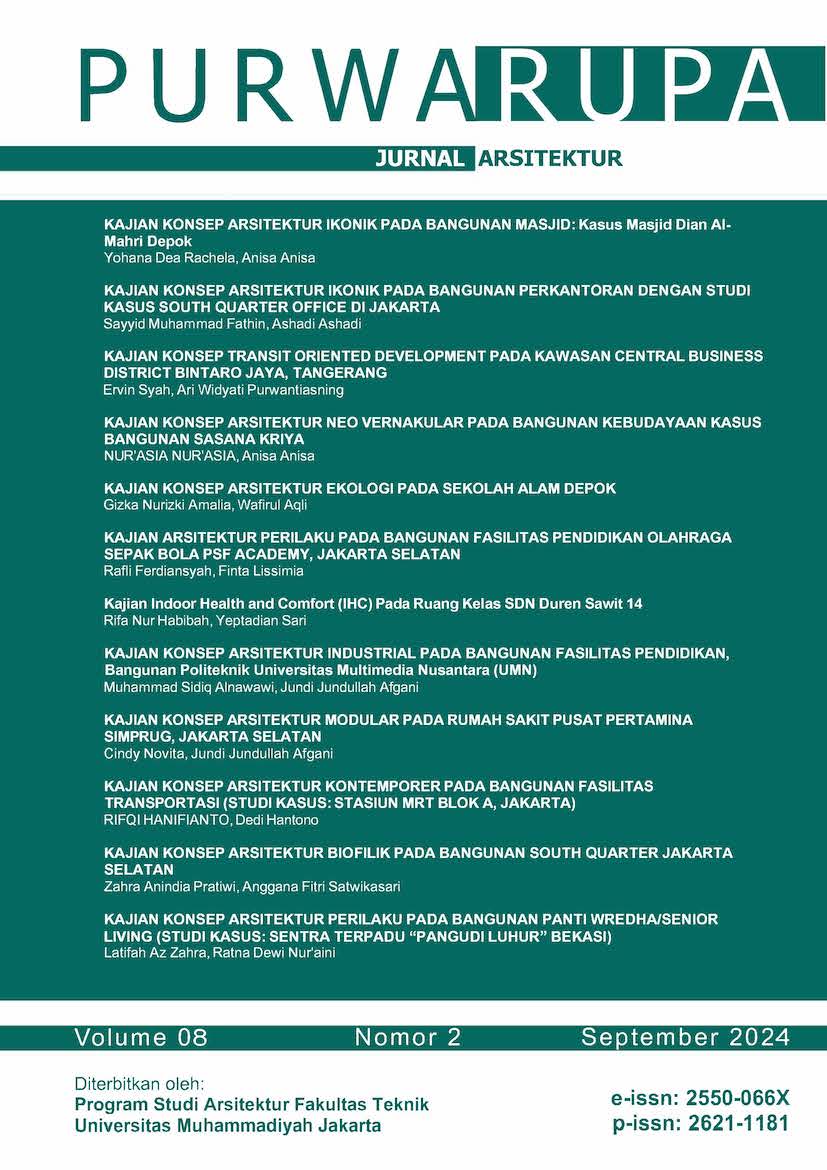KAJIAN KONSEP ARSITEKTUR EKOLOGI PADA SEKOLAH ALAM DEPOK
DOI:
https://doi.org/10.24853/purwarupa.8.2.125-130Abstrak
ABSTRAK. Setiap tahun, terjadi peningkatan kerusakan alam akibat pencemaran dan kegiatan konstruksi. Limbah dan eksploitasi bahan mentah oleh industri konstruksi merusak ekosistem, terutama di sekitar lokasi konstruksi, menyebabkan perubahan lingkungan yang signifikan. Meski demikian, upaya inovatif telah dilakukan untuk mengatasi masalah ini, termasuk melalui pendekatan arsitektur ekologi. Pendekatan ini menitikberatkan pada keberlanjutan dan keseimbangan ekologi dalam desain bangunan dan lingkungan. Tujuannya adalah menciptakan bangunan dan lingkungan yang ramah lingkungan, mengurangi dampak negatif, dan mendorong penggunaan sumber daya secara berkelanjutan. Implementasi arsitektur ekologi dalam bangunan pendidikan menjadi langkah penting untuk menciptakan lingkungan belajar yang berkelanjutan dan positif. Bangunan yang dirancang dengan baik dapat menciptakan atmosfer yang nyaman, memotivasi pembelajaran, dan menginspirasi pemikiran kreatif mengenai isu-isu lingkungan. Hal ini dianggap sebagai investasi dalam pendidikan berkelanjutan untuk generasi mendatang, di mana peserta didik dapat belajar secara langsung menghargai lingkungan.Kata Kunci: Arsitektur Ekologi, Ramah Lingkungan, Bangunan Pendidikan ABSTRACT. Every year, there is an increase in environmental damage due to pollution and construction activities. Waste and the exploitation of raw materials by the construction industry harm ecosystems, especially around construction sites, causing significant changes in the environment. Nevertheless, innovative efforts have been made to address this issue, including through the approach of ecological architecture. This approach emphasizes sustainability and ecological balance in the design of buildings and environments. The goal is to create environmentally friendly buildings and environments, reduce negative impacts, and promote the sustainable use of resources. The implementation of ecological architecture in educational buildings is a crucial step in creating a sustainable and positive learning environment. Well-designed buildings can create a comfortable atmosphere, motivate learning, and inspire creative thinking about environmental issues. This is considered an investment in sustainable education for future generations, where learners can directly learn to appreciate the environment. Keywords: Ecological Architecture, Environmentally Friendly, Educational BuildingsReferensi
Suskiyatno, H. F. (1998). Dasar-dasar eko-arsitektur. Yogyakarta: Kanisius.
Heinz Frick, F. B. (2007). Dasar-dasar arsitektur ekologi. Yogyakarta: Kanisius.
Abdul Azis Muslim, D. I. (2018). Konsep Arsitektur Ekologi Pada Penataan Kawasan Wisata Candi Cangkuang Di Garut, Jawa Barat. Jurnal Arsitektur PURWARUPA , (Volume 2 No 2 September 2018: 57-7).
Desak Made Sukma Widiyani, I. K. (2022). Konsep Eko Arsitektur Pada Desain Akomodasi Wisata Di Badung. Jurnal Teknik Gradien, Vol. 14, No. 02.
Risnan Nazarudin, A. (2021). Kajian Konsep Arsitektur Ekologi Pada Kawasan Hotel Alam Asri Resort . Rustic Jurnal Arsitek, E-ISSN: 2775-7528
##submission.downloads##
Diterbitkan
Cara Mengutip
Terbitan
Bagian
Lisensi
COPYRIGHT POLICY
The author(s) of an article published in the Jurnal Teknologi retains ownership of the intellectual property rights in work (s).
PUBLISHING RIGHTS
The author(s) of an article published in the Jurnal Teknologi have unrestricted publication rights. The authors give the Jurnal Teknologi the right to publish the article and designate the Faculty of Engineering Universitas Muhammadiyah Jakarta Publishing as the original publisher of the article.
LICENSING POLICY
Journal of Mechanical Engineering and Sciences is an open-access journal that follows the Creative Commons Non-Commercial 4.0 International License (CC BY-NC 4.0), which states that:

Under this license, the reusers must give appropriate credit, provide a link to the license, and indicate if changes were made. Users may do so in any reasonable manner, but not in any way that suggests the licensor endorses users or their use.
Please take the time to read the whole license agreement (https://creativecommons.org/licenses/by-nc/4.0/). As long as reusers follow the license conditions, the owner cannot withdraw these freedoms. The following components are included under this license:
 Attribution: Users must provide appropriate attribution, including a link to the license, and indicate whether or not they made any modifications. Users are free to do so reasonably, but not in a manner that indicates the licensee approves of their usage.
Attribution: Users must provide appropriate attribution, including a link to the license, and indicate whether or not they made any modifications. Users are free to do so reasonably, but not in a manner that indicates the licensee approves of their usage.
 NonCommercial: Users may not use the material for commercial purposes.
NonCommercial: Users may not use the material for commercial purposes.

